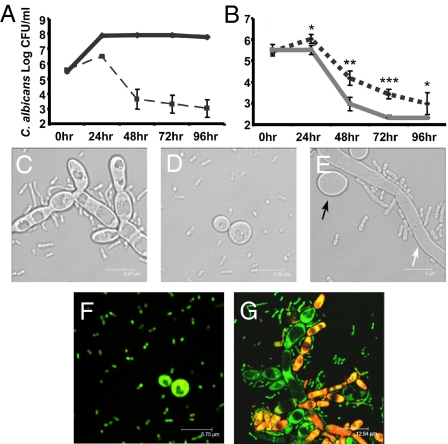Fig. 3.
A. baumannii has a predilection for killing C. albicans filaments in vitro. (A) The viability of C. albicans strain DAY185 (solid line) was significantly reduced when cocultured with A. baumannii (ATCC strain no. 19606) (dashed line). (B) A. baumannii caused more rapid killing of the constitutively filamentous C. albicans tup1 mutant (dotted line) compared with the hyphal-defective C. albicans mutant suv3 (gray solid line), which remains in yeast form at 30°C but can produce filaments at 37°C. In support, microscopy showed that A. baumannii cells have greater association with C. albicans filaments compared with the yeast form, tup1 (C), suv3 at 30°C (D), and suv3 at 37°C (E). The white arrow in E points to a C. albicans filament, whereas the black arrow points to a yeast cell. Cocultures with A. baumannii and C. albicans suv3 (F) and tup1 (G) mutants were stained with the LIVE/DEAD staining system. Viable cells stained green (SYTO9), whereas dead cells stained red (propidium iodide). Control cultures of C. albicans tup1 and suv3 mutants alone demonstrated green fluorescence (data not shown). All images were taken at 16–20 h. Asterisks denote comparison of Log CFU/ml between C. albicans tup1 and suv3 mutants when cocultured with A. baumannii. Results for the viability assays were derived from three independent experiments. (Scale bars: C, 6.87 μm; D, 6.35 μm; E, 6 μm; F, 8.75 μm; G, 12.54 μm.)

